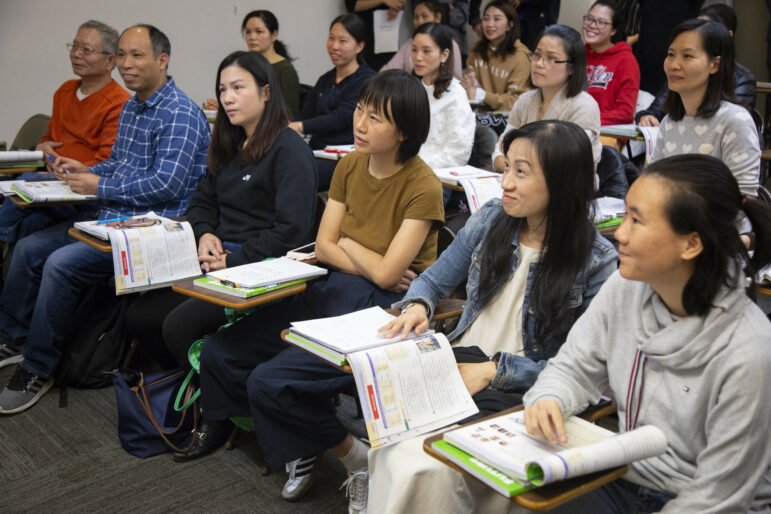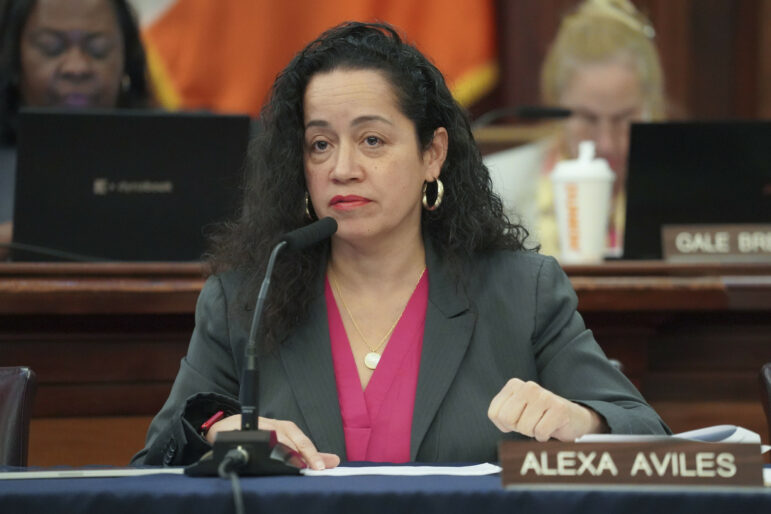Days before New York City’s final budget for the next fiscal year is due, both advocates and City Council members are urging that funding be maintained to reach a similar number of students served in the fiscal year that is about to end on July 1.

John McCarten/NYC Council
An adult education class Chinese-American Planning Council, Inc., in 2018.For New Yorkers over the age of 16 who are not enrolled in school and who can’t speak, read, and/or write English well enough to participate in an English-language education or training program, adult literacy classes are a key option.
Students who participated in the Chinese-American Planning Council’s adult literacy programs shared in a survey that their lives changed after these classes. “Of course it improved my life,” reads one of the responses in Spanish, shared with City Limits from an internal survey of students who recently completed the organization’s programs.
“Now I can write a little bit of English, read, or go out on the street and read words, know what they say when someone speaks, and be able to understand a little bit. I felt like I was going out blind or deaf,” the respondent said. Now, it “is like not going out blind and deaf anymore,” they added.
For years, the city’ Department of Youth and Community Development (DYCD) has been working with community organizations to develop an adult literacy system that provides reading, writing, English, and math classes.
Now, just days before New York City’s final budget for the next fiscal year is due, both advocates and City Council members are urging that funding be maintained to reach a similar number of students served in the fiscal year that is about to end on July 1.
The city budgeted $16.8 million for DYCD to bid on adult literacy programs through requests for proposals (RFPs) during the current fiscal year 2024. In the upcoming fiscal year, the Literacy Services RFP is baselined at $11.8 million, a $6 million reduction from previous years, or a cut of nearly 30 percent.
“Programs already only serve a very small fraction of students who need adult literacy skills,” Chinese-American Planning Council (CPC) Chief Policy and Public Affairs Officer Carlyn Cowen said.
”There are 2.2 million adults with limited English proficiency or who do not have a high school diploma. Last year, DYCD was only able to serve about 1 percent of these adults,” Cowen added. “With such a low percentage of need being served, with programs already critically underfunded, it is difficult to understand how DYCD and the city are able to make such draconian cuts to essential community programs.”
In addition to less funding overall, after years of advocating for a new price per participant (PPP) rate, the city agreed to change the per student per year rate from $900 to $1,300—which in turn would also reduce the number of students who can take part.
The New York City Coalition for Adult Literacy (NYCCAL) anticipates serving approximately 17,722 students this year. With the possible reduction in the budget, and considering the new PPP rate, they expect to reach just 9,118 students in the year ahead, a 48.5 percent reduction.
This cut would come at a time when providers of these programs have seen increased demand for classes, as more than 200,000 migrants and asylum seekers have arrived in the city in the last two years, tens of thousands of whom remain in the shelter system.
“This is coming at a time when the waitlist and demand for adult literacy programs has significantly increased citywide,” Cowen said, adding that there are hundreds of people on a waiting list for these classes, and many of them have recently arrived in the city.
To cover a population similar to what community-based organizations (CBOs) served this year, NYCCAL is asking for an additional $11 million: $6 million to cover what was previously allocated and $5 million to reach a similar number of students under the new per-student rate that will take effect in fiscal year 2025.
“Adult literacy is foundational programming for immigrants in our city. You can’t find a job, housing, education, health care, the list goes on, if you can’t fill out, read, or access the required documents,” said Councilmember Alexa Avilés, chair of the City Council’s Committee on Immigration. The Council is asking for an additional $10 million for DYCD programs.

Credit: Gerardo Romo / NYC Council Media Unit
City Councilmember Alexa Avilés, who chairs the Immigration Committee, at a preliminary budget hearing for DYCD in March.“$10 million is a drop in the bucket, and it has never been a question of if we have the money. We have it and then some. It’s entirely up to Mayor Adams and his administration to recognize that literacy is a lifeline for newly arrived New Yorkers, and must be a priority for this city,” Avilés said.
DYCD said that the city is working closely with the Council to support the priorities of both parties and will have more to say soon, adding that If additional funding is provided, they will increase the number of slots served.
“The Adams administration is committed to bringing equity to all New Yorkers, which is why DYCD developed a new RFP funding formula that incorporated poverty rates and expanded newly funded Adult Basic Education programs to communities such as East Harlem, Concourse Village, and Soundview,” DYCD Commissioner Keith Howard said in a statement.
“DYCD continues to make sure communities previously without literacy programs are getting the services they need, and our administration is working with the Council to support our mutual priorities in the adopted budget.”
While the CBOs say the RFP reformulation looks good on paper—it used data from the 2020 American Community Survey to identify areas with higher rates of poverty, lower educational attainment, and limited English proficiency, which are called “Neighborhood Tabulation Areas”—in practice, the reality is more complicated.
According to NYCCAL, many Neighborhood Tabulation Areas (NTA) have no existing DYCD-funded literacy, and while organizations can apply for funding even when they’re outside these areas, they fear they will only be considered if there are no viable proposals from programs within the zone.
“While the RFP was amended after a huge outcry to allow CBOs outside of the NTA to apply, it was also set up to prioritize organizations within the NTA, de facto creating barriers for organizations that have been doing this work in communities for decades,” Cowen said.
DYCD has been notifying CBOs since Friday on whether they won funding under the new RFP, but did not specify how many programs are expected to operate in fiscal year 2025 and how it compares to previous years, saying the number of programs will be available after all RFP awards are finalized.
“The recent RFP has been difficult on providers,” J.T. Falcone, United Neighborhood Houses’ communications director, wrote via email. “Some awards have been made at this point, but a lack of clear communication from DYCD has created a destabilizing environment where contracts are set to end at the end of the month, but we don’t know where the new ones will be going forward.”
Program providers who spoke to City Limits fear that between budget cuts and the new formula for awarding contracts, the city’s adult literacy program system will undergo a multi-level restructuring that will ultimately affect those who need these classes.
“We anticipate some providers who aren’t awarded new contracts will have to do layoffs, but we still don’t have clear guidance from the City on how to handle those, which has been difficult,” Falcone added.
To reach the reporter behind this story, contact Daniel@citylimits.org. To reach the editor, contact Jeanmarie@citylimits.org
Want to republish this story? Find City Limits’ reprint policy here.








